Search
Latest topics
» Happy Birthday!!by AtlantaMarie Today at 7:11 am
» How best to keep a fallow SFG bed
by KiwiSFGnewbie Yesterday at 9:14 pm
» Thai Basil
by markqz Yesterday at 1:40 pm
» Preserving A Bumper Tomato Harvest with Freezing vs Canning
by plantoid Yesterday at 11:36 am
» New SFG gardener in Auckland
by sanderson Yesterday at 12:14 am
» Mark's first SFG
by sanderson 11/6/2024, 11:51 pm
» Need Garden Layout Feedback
by sanderson 11/5/2024, 2:33 pm
» What Have You Picked From Your Garden Today
by OhioGardener 11/5/2024, 2:29 pm
» Greetings from Southeastern Wisconsin
by sanderson 11/5/2024, 2:01 pm
» N & C Midwest: Nov. Dec. 2024
by Scorpio Rising 11/3/2024, 3:51 pm
» Spinning Compost Bin-need some ideas
by rtfm 11/2/2024, 7:49 pm
» Kiwi's SFG Adventure
by KiwiSFGnewbie 10/31/2024, 9:55 pm
» Growing fruit trees in Auckland
by OhioGardener 10/31/2024, 4:23 pm
» Vermiculite -- shipping sale through 10/31/2024
by markqz 10/30/2024, 2:27 pm
» N & C Midwest: October 2024
by Scorpio Rising 10/30/2024, 10:38 am
» What are you eating from your garden today?
by Scorpio Rising 10/27/2024, 10:27 pm
» Old Mulch and Closing Beds for Winter
by sanderson 10/26/2024, 11:00 pm
» Ohio Gardener's Greenhouse
by OhioGardener 10/25/2024, 7:17 pm
» Hello from Land of Umpqua, Oregon Zone 8b
by sanderson 10/25/2024, 3:14 pm
» Hello everyone!
by SFGHQSTAFF 10/24/2024, 3:22 pm
» Senior Gardeners
by sanderson 10/23/2024, 6:09 pm
» Hello from South Florida
by markqz 10/23/2024, 10:30 am
» Confirm what this is
by sanderson 10/11/2024, 2:51 pm
» Harlequin Beetles?
by sanderson 10/7/2024, 3:08 pm
» N & C Midwest: September 2024
by OhioGardener 9/30/2024, 4:13 pm
» The SFG Journey-Biowash
by OhioGardener 9/29/2024, 8:33 am
» Fall is For Garlic Planting
by Scorpio Rising 9/28/2024, 12:19 am
» source for chemical-free lanscape fabric
by Woodsong 9/19/2024, 10:51 am
» Hurricane
by sanderson 9/14/2024, 5:42 pm
» Pest Damage
by WBIowa 9/8/2024, 2:48 pm
Google
Black Walnut Toxicity
+3
florenceq
boffer
UnderTheBlackWalnut
7 posters
Page 1 of 1
 Black Walnut Toxicity
Black Walnut Toxicity
Hi!
I've been promising that I would provide some of the information I've gleaned about black walnut toxicity and which plants/veggies are more tolerant and which are less. (BBG if I've put this in the wrong place, can you please move it? Wasn't sure where it needed to go.) For those of you who have not heard of "black walnut wilt", black walnuts secrete a chemical called "juglone" which can be damaging to some other plants and trees and cause them to yellow, wilt, and even die, for what appears to be no reason.
For those of you who have not heard of "black walnut wilt", black walnuts secrete a chemical called "juglone" which can be damaging to some other plants and trees and cause them to yellow, wilt, and even die, for what appears to be no reason.  (They also can be detrimental to horses as well when used for bedding, I believe.) Since most of my backyard is a lovely HUGE old black walnut tree (the house was built in 1912 so it's very possible the tree was already here), I'm always looking for input from others on how they work around such a lovely but challenging tree.
(They also can be detrimental to horses as well when used for bedding, I believe.) Since most of my backyard is a lovely HUGE old black walnut tree (the house was built in 1912 so it's very possible the tree was already here), I'm always looking for input from others on how they work around such a lovely but challenging tree.
First, how do you know a black walnut tree? The most obvious way is by the green "tennis-ball" nuts that it drops in late summer/fall. These are the husks of the black walnut nuts and inside is the smaller black walnut, with a deeply grooved shell that most old-timers will tell you they used to run over with their cars to actually crack. The leaves are not that pretty and only yellow in fall, (not like the beautiful maple trees in our area), but the bark is gray-brown and deeply grooved and the tree grows in such a way that it's branches are arm-like which almost gives it a personality of it's own.
The leaves are not that pretty and only yellow in fall, (not like the beautiful maple trees in our area), but the bark is gray-brown and deeply grooved and the tree grows in such a way that it's branches are arm-like which almost gives it a personality of it's own.
I've run across an informative article about how to identify a black walnut tree here:
http://forestry.about.com/od/hardwoods/ss/walnut.htm
Here is another:
http://www.dnr.state.oh.us/trees/walnut_black/tabid/5431/Default.aspx
What the heck will it do to my 'maters? Here are some articles from some of the extension services in the midwest about black walnut toxicity. They include lists of plants that have been found to grow under black walnuts as well as those which are sensitive to juglone. SENSITIVE VEGGIES are listed as tomatoes, peppers, cabbage, potatoes, eggplant, blueberries, blackberries, asparagus, rhubarb, tobacco, and "double flowered cole vegetables". I know a cole veggie is like broccoli/cauliflower/brussels sprouts/kale, but not sure what "double flowered cole vegetable" is?? :scratch: Juglone is found in every part of the black walnut, but especially the roots. One site says leaves can be composted but care has to be taken that it is composted long enough (one site says six months if you are growing juglone-sensitive plants). NEVER use wood shavings for mulch around any sensitive plants. More information about what trees, flowers, shrubs, veggies are tolerant/intolerant can be found in these articles.
Here are some articles from some of the extension services in the midwest about black walnut toxicity. They include lists of plants that have been found to grow under black walnuts as well as those which are sensitive to juglone. SENSITIVE VEGGIES are listed as tomatoes, peppers, cabbage, potatoes, eggplant, blueberries, blackberries, asparagus, rhubarb, tobacco, and "double flowered cole vegetables". I know a cole veggie is like broccoli/cauliflower/brussels sprouts/kale, but not sure what "double flowered cole vegetable" is?? :scratch: Juglone is found in every part of the black walnut, but especially the roots. One site says leaves can be composted but care has to be taken that it is composted long enough (one site says six months if you are growing juglone-sensitive plants). NEVER use wood shavings for mulch around any sensitive plants. More information about what trees, flowers, shrubs, veggies are tolerant/intolerant can be found in these articles.
Ohio State University Fact Sheet-Black Walnut
University of Wisconsin Cooperative Extension-Black Walnut
Purdue University Cooperative Extension-Black Walnut
Lastly, because everyone loves pictures....here ya go...
RAINY YUCKY MUDDY yard with tree (we've trimmed lower branches out in order to get some sun)- can't even get the top of it in the picture. STRIPE ON BARK IS JUST FROM RAIN...it does not normally look that way. Forgive what I am ashamed to even call "grass" - with our tree and more dogs than is sane, if it's green, we keep it.
Forgive what I am ashamed to even call "grass" - with our tree and more dogs than is sane, if it's green, we keep it.  Good thing that the pink dogwood is tolerant, because I love it.
Good thing that the pink dogwood is tolerant, because I love it. 
Currently my SFG boxes are starting out way up by my deck (which you can see in the foreground) and we'll see how that goes....(The book says to put them close by...so I'm trying it this way to start.) I plan to police them vigilantly to remove any debris that may fall into the MM from the tree.

Top of tree...
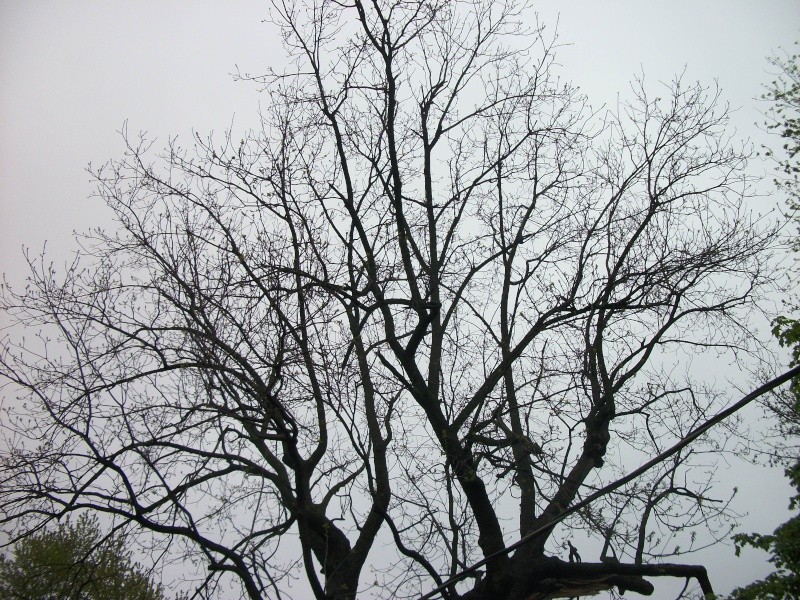
Tree with standard plastic resin patio chair in front of the trunk for size comparison...again yucky muddy yard....complete with "doggie trails"
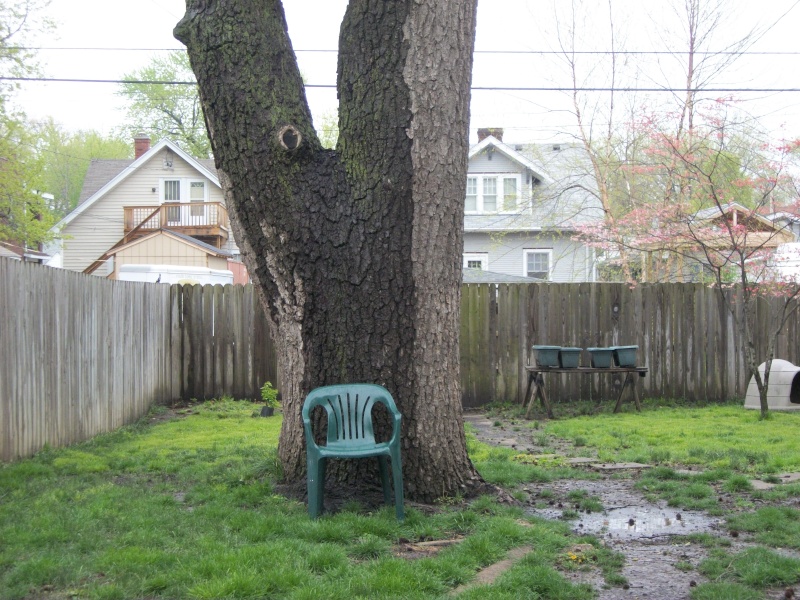
Closeup of tree bark...

Looking up into tree last August with foliage when large branch broke off (according to arborist it was a more "horizontal" branch and last year was a good production year so it just got too heavy for itself)
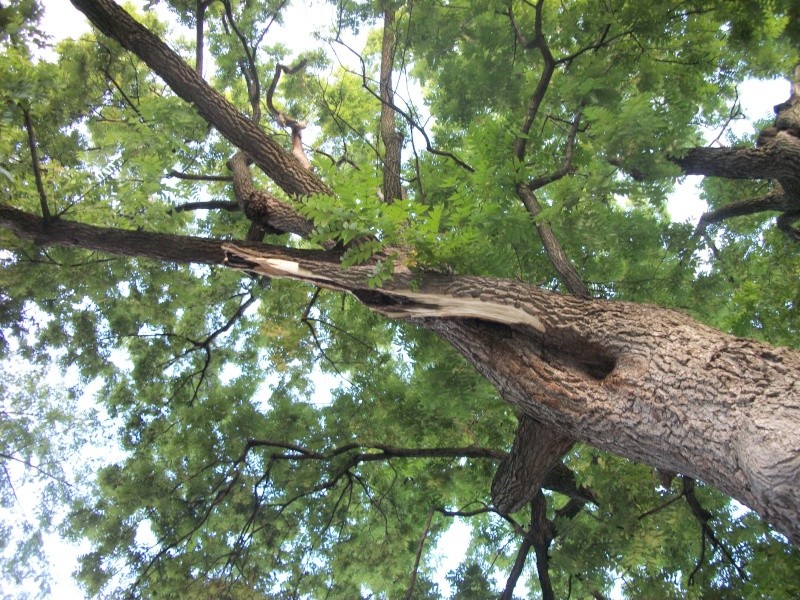
Slightly smaller than tennis-balls, black walnuts on branch that broke off
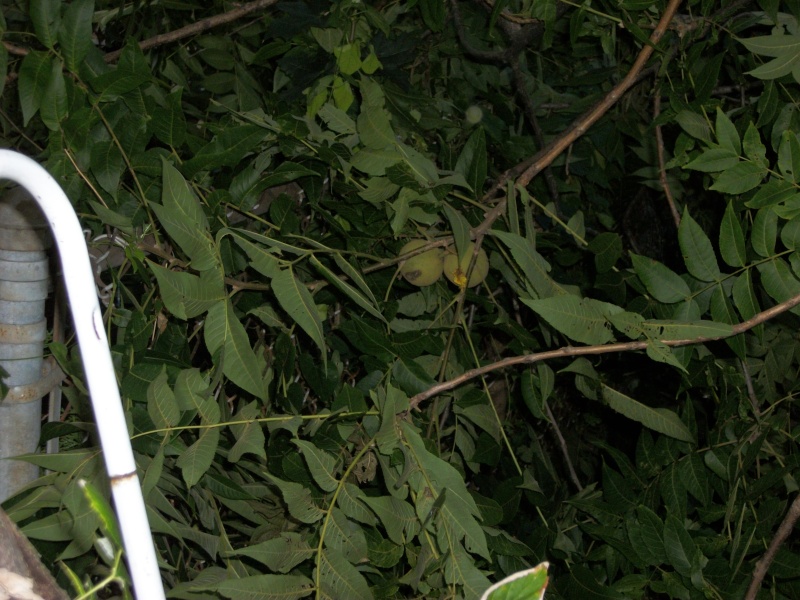
Black walnuts after we clean the hulls off and dry them...IF you can crack them open without destroying the nutmeats, they are strong flavored and wonderful... (penny is in picture for perspective)
(penny is in picture for perspective)

Well folks, that's all I have learned about black walnuts. I haven't been able to do much gardening before (just some potted herbs and a few annuals and a couple of perennials in a small area away from the tree), so I am clueless in so many other areas that I know will come up during the season. However, I AM SO EXCITED to finally have a viable solution which will allow me to grow some "eats", in a small space with a chemically dominant tree. Thank you SFG! I really appreciate how willing all of you are to answer questions and how much of a goldmine of knowledge this forum already contains. I would welcome anyone's input to add to what I've already found.
Smiles,
Maria (UnderTheBlackWalnut)
I've been promising that I would provide some of the information I've gleaned about black walnut toxicity and which plants/veggies are more tolerant and which are less. (BBG if I've put this in the wrong place, can you please move it? Wasn't sure where it needed to go.)
 (They also can be detrimental to horses as well when used for bedding, I believe.) Since most of my backyard is a lovely HUGE old black walnut tree (the house was built in 1912 so it's very possible the tree was already here), I'm always looking for input from others on how they work around such a lovely but challenging tree.
(They also can be detrimental to horses as well when used for bedding, I believe.) Since most of my backyard is a lovely HUGE old black walnut tree (the house was built in 1912 so it's very possible the tree was already here), I'm always looking for input from others on how they work around such a lovely but challenging tree. First, how do you know a black walnut tree? The most obvious way is by the green "tennis-ball" nuts that it drops in late summer/fall. These are the husks of the black walnut nuts and inside is the smaller black walnut, with a deeply grooved shell that most old-timers will tell you they used to run over with their cars to actually crack.
I've run across an informative article about how to identify a black walnut tree here:
http://forestry.about.com/od/hardwoods/ss/walnut.htm
Here is another:
http://www.dnr.state.oh.us/trees/walnut_black/tabid/5431/Default.aspx
What the heck will it do to my 'maters?
Ohio State University Fact Sheet-Black Walnut
University of Wisconsin Cooperative Extension-Black Walnut
Purdue University Cooperative Extension-Black Walnut
Lastly, because everyone loves pictures....here ya go...
RAINY YUCKY MUDDY yard with tree (we've trimmed lower branches out in order to get some sun)- can't even get the top of it in the picture. STRIPE ON BARK IS JUST FROM RAIN...it does not normally look that way.
Currently my SFG boxes are starting out way up by my deck (which you can see in the foreground) and we'll see how that goes....(The book says to put them close by...so I'm trying it this way to start.) I plan to police them vigilantly to remove any debris that may fall into the MM from the tree.

Top of tree...

Tree with standard plastic resin patio chair in front of the trunk for size comparison...again yucky muddy yard....complete with "doggie trails"

Closeup of tree bark...

Looking up into tree last August with foliage when large branch broke off (according to arborist it was a more "horizontal" branch and last year was a good production year so it just got too heavy for itself)

Slightly smaller than tennis-balls, black walnuts on branch that broke off

Black walnuts after we clean the hulls off and dry them...IF you can crack them open without destroying the nutmeats, they are strong flavored and wonderful...

Well folks, that's all I have learned about black walnuts. I haven't been able to do much gardening before (just some potted herbs and a few annuals and a couple of perennials in a small area away from the tree), so I am clueless in so many other areas that I know will come up during the season. However, I AM SO EXCITED to finally have a viable solution which will allow me to grow some "eats", in a small space with a chemically dominant tree. Thank you SFG! I really appreciate how willing all of you are to answer questions and how much of a goldmine of knowledge this forum already contains. I would welcome anyone's input to add to what I've already found.
Smiles,
Maria (UnderTheBlackWalnut)
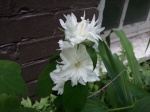
UnderTheBlackWalnut-
 Posts : 556
Posts : 556
Join date : 2011-04-18
Age : 58
Location : Springfield (central), IL, on the line between 5b and 6a
 Re: Black Walnut Toxicity
Re: Black Walnut Toxicity
Okie Dokie. You're the forum's new Black Walnut Expert! J/K My wife claims this is a black walnut; it gets fruit like you describe. See the 1x3 boxes? They are full of Mel's Mix, yet nothing grows well in them where they are located. I've tried peas, beans, rads, beets, and onions. I replaced the MM at one point.
Is the black walnut toxicity in the ground or in the air? (I finally gave up this year and moved the boxes and trellis to another location)

Is the black walnut toxicity in the ground or in the air? (I finally gave up this year and moved the boxes and trellis to another location)

 Re: Black Walnut Toxicity
Re: Black Walnut Toxicity
boffer wrote:
Is the black walnut toxicity in the ground or in the air? (I finally gave up this year and moved the boxes and trellis to another location)
Wow, I didn't think BW trees were native to areas west of South Dakota. I'm NOT an arborist, but I would say if your tree meets all the descriptions in the documentation above, then it's possible it is a black walnut, but just not native. It looks young. Do you know if someone purposefully planted the tree there? Are there others in the area?
Toxicity is definitely in the ground and can be past the dripline of the tree. From what I've read it is NOT airborne. BUT, in my experience, if leaves/twigs/buds or what-have-you from the tree fall in my pots, that plant will start to have problems if I don't remove them.
The Purdue article says, "If proximity to such trees is unavoidable, then raised beds afford a means of protection. However, the bed must be constructed in such a way as to minimize tree root penetration into the raised portion. Care must be taken to keep the beds free of black walnut leaf litter or nuts. If a garden is separated from a black walnut tree by a rock wall, driveway, or other physical barrier, then root extension growth into the garden area may be limited and juglone toxicity problems minimized."
What happened to your plants? Mine will generally start to turn yellow/look pale and then begin to wilt.
The other funny thing is that beets, beans and onions are supposed to be juglone tolerant. It doesn't list peas or rads in either category. I don't have much experience even with juglone tolerant plants, but I have a few raspberry canes (listed as tolerant) which have survived, largely ignored by me, under the dripline and in the ground. But then, that's raspberry, right?
Were the plants you had trouble with ones that you were also growing in other areas successfully? THAT would also seem consistent with the fact that it had something to do with the tree.

UnderTheBlackWalnut-
 Posts : 556
Posts : 556
Join date : 2011-04-18
Age : 58
Location : Springfield (central), IL, on the line between 5b and 6a
 Re: Black Walnut Toxicity
Re: Black Walnut Toxicity
You're right; it's not native. My wife, and mostly her brother, are 'in' to growing non-native plants. We have some palm trees, and some orchids from the mountains of Peru.
My horticultural interests are basic and boring; I grow the easy stuff. At least the stuff I grow is edible!
I don't have trouble growing any of the stuff I mentioned any other places. The plants were lethargic compared to what we had growing elsewhere. The root stuff never fully developed. It's an anomaly; we moved the boxes away from the tree. We'll see this year.
My horticultural interests are basic and boring; I grow the easy stuff. At least the stuff I grow is edible!

I don't have trouble growing any of the stuff I mentioned any other places. The plants were lethargic compared to what we had growing elsewhere. The root stuff never fully developed. It's an anomaly; we moved the boxes away from the tree. We'll see this year.
 Re: Black Walnut Toxicity
Re: Black Walnut Toxicity
Yep - I'm betting it was the tree then...  Glad to know it's not just me.
Glad to know it's not just me.
 UTBW
UTBW

UnderTheBlackWalnut-
 Posts : 556
Posts : 556
Join date : 2011-04-18
Age : 58
Location : Springfield (central), IL, on the line between 5b and 6a
 Re: Black Walnut Toxicity
Re: Black Walnut Toxicity
Dumb question.................are these the same walnuts you buy in the store?
Last Christmas I bought a mixed bag of nuts still in shells. When we ate those nuts we put the shells in the compost bin. If these are the same nuts you are describing is my compost ruined?
Last Christmas I bought a mixed bag of nuts still in shells. When we ate those nuts we put the shells in the compost bin. If these are the same nuts you are describing is my compost ruined?

florenceq-
 Posts : 69
Posts : 69
Join date : 2010-12-27
Age : 52
Location : Santee, CA 92071
 Re: Black Walnut Toxicity
Re: Black Walnut Toxicity
(BBG if I've put this in the wrong place, can you please move it? Wasn't sure where it needed to go.)
This is perfect for it. Thanks for doing this; I am just now starting to read it. We are getting more dad-gummed severe weather tonight, so I'll be sporadic. I hope to get this topic read and replied to if I find anything to comment on.
I can guarantee you, though, I will be saying a big thank you for your contribution. This article/description looks very thorough. I really appreciate the time you must have spent putting this in type.


BackyardBirdGardner-
 Posts : 2710
Posts : 2710
Join date : 2010-12-25
Age : 50
Location : St. Louis, MO
 Re: Black Walnut Toxicity
Re: Black Walnut Toxicity
florenceq wrote:Dumb question.................are these the same walnuts you buy in the store?
Last Christmas I bought a mixed bag of nuts still in shells. When we ate those nuts we put the shells in the compost bin. If these are the same nuts you are describing is my compost ruined?
Hi Florenceq - No question is ever dumb!
I'm almost positive that your shells were PERSIAN/ENGLISH walnuts. Those do not have any known toxicity to plants according to the Ohio State article. Most unshelled nuts sold in stores are of this variety.
I have NEVER seen black walnuts available in stores unshelled. The reason is they are EXTREMELY hard to crack. You can NOT crack them with a standard nutcracker. It takes a hammer, vise, back of an axe, car tire...you get the picture. They do sometimes appear shelled in small bags for baking, etc...and are quite expensive due to the processing costs.
I'm including pictures for you so you can see the difference.
English Walnut
Black Walnut
There is also a picture of black walnuts in my original post in this thread.
I am fairly certain that you have NOTHING to worry about in terms of any walnut toxicity in your compost from store-bought nut shells.

UnderTheBlackWalnut-
 Posts : 556
Posts : 556
Join date : 2011-04-18
Age : 58
Location : Springfield (central), IL, on the line between 5b and 6a
 Re: Black Walnut Toxicity
Re: Black Walnut Toxicity
If I can add two things I've noticed as I read...
- Planting non-native plants is a horrible idea. Some become parasitic and invasive drastically throwing off the local areas ecology and ecosystems....ruining native species' habitats. Take for instance the House Sparrow and European Starling....displacing native sparrows and other birds like woodpeckers, bluebirds, and wrens. Not to mention Kudzu in the Atlanta area and the southeast. Japanese carp are also put into ponds to eat algae, but instead wipeout native species of fish by throwing off the balance of the lake/water. It's a dangerous toy to play with. I encourage caution when bringing anything home whether it be a walnut tree or a peruvian orchid. We all know from being gardeners....you don't mess with Mother Nature. She has a rhyme and reason for everything. /rant
- Have you seen my netting over my garden, UBW? Standard bird netting draped over covered wagon style hoops may keep falling debris out of your garden....making things easier to prevent.
Great article. And, Boffer, you know that isn't aimed at you, personally, right? It's a generic statement that you just happened to bring up.
- Planting non-native plants is a horrible idea. Some become parasitic and invasive drastically throwing off the local areas ecology and ecosystems....ruining native species' habitats. Take for instance the House Sparrow and European Starling....displacing native sparrows and other birds like woodpeckers, bluebirds, and wrens. Not to mention Kudzu in the Atlanta area and the southeast. Japanese carp are also put into ponds to eat algae, but instead wipeout native species of fish by throwing off the balance of the lake/water. It's a dangerous toy to play with. I encourage caution when bringing anything home whether it be a walnut tree or a peruvian orchid. We all know from being gardeners....you don't mess with Mother Nature. She has a rhyme and reason for everything. /rant
- Have you seen my netting over my garden, UBW? Standard bird netting draped over covered wagon style hoops may keep falling debris out of your garden....making things easier to prevent.
Great article. And, Boffer, you know that isn't aimed at you, personally, right? It's a generic statement that you just happened to bring up.

BackyardBirdGardner-
 Posts : 2710
Posts : 2710
Join date : 2010-12-25
Age : 50
Location : St. Louis, MO
 Re: Black Walnut Toxicity
Re: Black Walnut Toxicity
Thanks for this post! I have just started to look into this because I live in an area with tons of these darn trees everyone! We took one down in our backyard last year because it was mostly dead so my backyard is safe. But my next door neighbor has one in her front yard about 10 or 15 yards from the property line. My sweetgum is doing okay I guess but I can't find any info on weather a Pawpaw tree would be resistant to the toxins and that is what we hope to put in that area when we eventually take down a dead Ash tree nearby.

Glendale-gardener-
 Posts : 293
Posts : 293
Join date : 2011-03-10
Age : 49
Location : Cincinnati Zone 6A
 Re: Black Walnut Toxicity
Re: Black Walnut Toxicity
BBG - great idea 
Glendale - Sounds like we are in the same backyard! Though I'm very glad my tree is alive and well because I've heard it's terribly expensive to take such a large tree down.
Though I'm very glad my tree is alive and well because I've heard it's terribly expensive to take such a large tree down.
Seems like the Cincinnati contingent is alive and well in the forums. My stepson manages a store at Florence Mall in the Northern KY region so I do get out that way once in a while. I, too, have noticed that while it's awesome to have the lists of tolerant/intolerant plants that they aren't super inclusive. I do hate that azaleas and rhododendrons are on the intolerant list. Sometimes it's just trial-and-error, isn't it?
Sometimes it's just trial-and-error, isn't it?
So far, I've had some success with the following in the dripline, near edges:
raspberries, a dogwood tree, lilacs ON THE FAR EDGE OF THE DRIPLINE (which can be intolerant- I've had a Miss Kim which died due to dog-trampling, and this year put in a Declaration and Old Fashioned-so far so good), hostas, hyacinth, black-eyed susans, sunflowers (but they were as far away from the dripline as I could get which amounted to maybe 10-15 feet outside), jonquils (but the tulips never do as well), rose-of-sharon (grows like a weed in these parts - couldn't get rid of it if I wanted to)
This year a friend is giving me some Solomon's seal and I'm going to see if I can get it to take. Hubby likes bluebells and "wildflowers" so let me know if you've had success with anything in your neck of the woods.

Glendale - Sounds like we are in the same backyard!
Seems like the Cincinnati contingent is alive and well in the forums. My stepson manages a store at Florence Mall in the Northern KY region so I do get out that way once in a while. I, too, have noticed that while it's awesome to have the lists of tolerant/intolerant plants that they aren't super inclusive. I do hate that azaleas and rhododendrons are on the intolerant list.
So far, I've had some success with the following in the dripline, near edges:
raspberries, a dogwood tree, lilacs ON THE FAR EDGE OF THE DRIPLINE (which can be intolerant- I've had a Miss Kim which died due to dog-trampling, and this year put in a Declaration and Old Fashioned-so far so good), hostas, hyacinth, black-eyed susans, sunflowers (but they were as far away from the dripline as I could get which amounted to maybe 10-15 feet outside), jonquils (but the tulips never do as well), rose-of-sharon (grows like a weed in these parts - couldn't get rid of it if I wanted to)
This year a friend is giving me some Solomon's seal and I'm going to see if I can get it to take. Hubby likes bluebells and "wildflowers" so let me know if you've had success with anything in your neck of the woods.

UnderTheBlackWalnut-
 Posts : 556
Posts : 556
Join date : 2011-04-18
Age : 58
Location : Springfield (central), IL, on the line between 5b and 6a
 Re: Black Walnut Toxicity
Re: Black Walnut Toxicity
I'm almost positive that your shells were PERSIAN/ENGLISH walnuts. Those do not have any known toxicity to plants according to the Ohio State article. Most unshelled nuts sold in stores are of this variety.
I have NEVER seen black walnuts available in stores unshelled. The reason is they are EXTREMELY hard to crack. You can NOT crack them with a standard nutcracker. It takes a hammer, vise, back of an axe, car tire...you get the picture. They do sometimes appear shelled in small bags for baking, etc...and are quite expensive due to the processing costs.

Thanks for the info. I definetly have English walnuts so I am good!
I have NEVER seen black walnuts available in stores unshelled. The reason is they are EXTREMELY hard to crack. You can NOT crack them with a standard nutcracker. It takes a hammer, vise, back of an axe, car tire...you get the picture. They do sometimes appear shelled in small bags for baking, etc...and are quite expensive due to the processing costs.

Thanks for the info. I definetly have English walnuts so I am good!

florenceq-
 Posts : 69
Posts : 69
Join date : 2010-12-27
Age : 52
Location : Santee, CA 92071
 is compost from black walnut leaves also toxic?
is compost from black walnut leaves also toxic?
Is compost from black walnut trees also toxic? I live in a heavily shaded lot (my veggie garden is elsewhere) but I want to use my leaf mold compost. Mostly black cherries, maples, and elm, but in the area there are some black walnut trees. If the leaf mold is also toxic, how much of the compost could be made up of black walnut leaves before you have a problem?
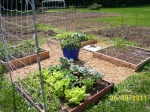
squaredeal-
 Posts : 192
Posts : 192
Join date : 2011-05-09
Location : Indianapolis=6a
 Re: Black Walnut Toxicity
Re: Black Walnut Toxicity
Hi squaredeal!
I have read conflicting advice.
Ohio State extension says "Walnut leaves can be composted because the toxin breaks down when exposed to air, water and bacteria. The toxic effect can be degraded in two to four weeks. In soil, breakdown may take up to two months. Black walnut leaves may be composted separately, and the finished compost tested for toxicity by planting tomato seedlings in it. Sawdust mulch, fresh sawdust or chips from street tree prunings from black walnut are not suggested for plants sensitive to juglone, such as blueberry or other plants that are sensitive to juglone. However, composting of bark for a minimum of six months provides a safe mulch even for plants sensitive to juglone."
University of Wisonsin says not to use bark/wood for mulch, but they don’t say anything about composting.
Purdue says “Leaves, bark, or wood chips of black walnut should not be used to mulch sensitive landscape or garden plants. Even after a period of composting, such refuse may release small amounts of juglone.”
The leaves don't have as much juglone as the roots, bark, buds, etc. I, myself, haven't tried it because the ONLY tree I really have is black walnut. If it was me, I'd probably make sure it had adequate time to compost and then try planting the tomato seedling in it to see if it's viable.
Perhaps someone else on the forum has experience with composting black walnut???? I'd be interested to know what you decide.
I have read conflicting advice.

Ohio State extension says "Walnut leaves can be composted because the toxin breaks down when exposed to air, water and bacteria. The toxic effect can be degraded in two to four weeks. In soil, breakdown may take up to two months. Black walnut leaves may be composted separately, and the finished compost tested for toxicity by planting tomato seedlings in it. Sawdust mulch, fresh sawdust or chips from street tree prunings from black walnut are not suggested for plants sensitive to juglone, such as blueberry or other plants that are sensitive to juglone. However, composting of bark for a minimum of six months provides a safe mulch even for plants sensitive to juglone."
University of Wisonsin says not to use bark/wood for mulch, but they don’t say anything about composting.
Purdue says “Leaves, bark, or wood chips of black walnut should not be used to mulch sensitive landscape or garden plants. Even after a period of composting, such refuse may release small amounts of juglone.”
The leaves don't have as much juglone as the roots, bark, buds, etc. I, myself, haven't tried it because the ONLY tree I really have is black walnut. If it was me, I'd probably make sure it had adequate time to compost and then try planting the tomato seedling in it to see if it's viable.
Perhaps someone else on the forum has experience with composting black walnut???? I'd be interested to know what you decide.


UnderTheBlackWalnut-
 Posts : 556
Posts : 556
Join date : 2011-04-18
Age : 58
Location : Springfield (central), IL, on the line between 5b and 6a
 Re: Black Walnut Toxicity
Re: Black Walnut Toxicity
florenceq wrote:I'm almost positive that your shells were PERSIAN/ENGLISH walnuts. Those do not have any known toxicity to plants according to the Ohio State article. Most unshelled nuts sold in stores are of this variety.
I have NEVER seen black walnuts available in stores unshelled. The reason is they are EXTREMELY hard to crack. You can NOT crack them with a standard nutcracker. It takes a hammer, vise, back of an axe, car tire...you get the picture. They do sometimes appear shelled in small bags for baking, etc...and are quite expensive due to the processing costs.
Thanks for the info. I definetly have English walnuts so I am good!
I actually saw some at the grocery store yesterday. Plainly labeled Black Walnuts. Didn't check the price.
A WEED IS A FLOWER GROWING IN THE WRONG PLACE
Elizabeth City, NC
Click for weather forecast

walshevak
Certified SFG Instructor-
 Posts : 4370
Posts : 4370
Join date : 2010-10-17
Age : 81
Location : wilmington, nc zone 8
 Re: Black Walnut Toxicity
Re: Black Walnut Toxicity
Wow walshevak! I have seen shelled black walnuts, but I have never seen UNshelled black walnuts! I can't imagine why anyone would want to BUY them unshelled as they are a pain in the neck to crack! :scratch: Based on some websites I checked, it seemed like the shelled black walnuts ran $5 to $7 more per pound than the shelled English walnuts. You are way ahead of me on this one! 

UnderTheBlackWalnut-
 Posts : 556
Posts : 556
Join date : 2011-04-18
Age : 58
Location : Springfield (central), IL, on the line between 5b and 6a
 Similar topics
Similar topics» Will an SFG survive near a Black Walnut?
» Black walnut in compost?
» UnderTheBlack Walnut is having a Birthday 08/17
» Composting walnut shells?
» Blueberry, junberry (serviceberry) and walnut tree: Are they friends to each other?
» Black walnut in compost?
» UnderTheBlack Walnut is having a Birthday 08/17
» Composting walnut shells?
» Blueberry, junberry (serviceberry) and walnut tree: Are they friends to each other?
Page 1 of 1
Permissions in this forum:
You cannot reply to topics in this forum









